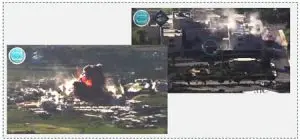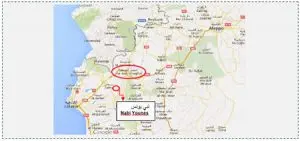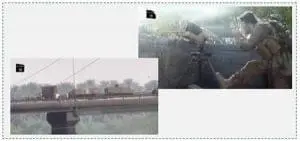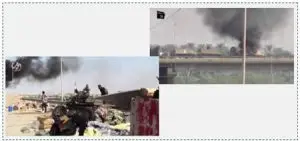Three days after American jihadists Elton Simpson and Nadir Soofi’s attempted to kill the participants of the Mohammed Cartoon competition in Garland, Texas, was foiled, Defense Secretary Ash Carter acknowledged that “ISIS remains a continuing threat and it is a movement that can inspire others far removed from Iraq and Syria to commit acts of violence.”
But many, in and out of government, minimize the jihadi threat in the U.S. They want us to believe that jihad is largely a matter of “lone wolves” killing “just a few Americans.” The same people are now celebrating today’s Second Circuit Court of Appeals’ ruling that the NSA’s telephone metadata collection program “is illegal under the Patriot Act.” This decision, and legislation pending in Congress to kill the NSA’s program, would prevent early detection of attacks on Americans at home.
Meanwhile, as the Washington Post article “From hip-hop to jihad, how the Islamic State became a magnet for converts” reveals, as many as a quarter of new Western recruits to ISIS are converts to Islam. The story reaffirms the view that ISIS’s successful propaganda and disinformation presses the right buttons among young Western Muslims and disaffected non-Muslims alike, and spares no expense for the most sophisticated social media and marketing technologies to spread their poison.
Even Carter’s statement before the Senate indicates that the U.S. authorities are taking ISIS’s statements of credit for the foiled shooting in Garland, Texas, more seriously. And the FBI seems to be building a case that the Garland perpetrators were in touch with ISIS. And judging by flood of congratulations from ISIS and praise of the Garland shooters on social media, Americans need more counterterrorism measures now more than ever before.
Indeed, global jihad continues apace. The Meir Amit Intelligence and Terrorism Information Center highlights ISIS and other jihadist activities between April 30 and May 6, 2015.*
The battle for hearts and minds
On April 28, 2015, photos were posted on Twitter taken by ISIS operatives in Rome. The operatives were holding a note that read “The Islamic State” and The Islamic State remains unchanged”. The account holders who posted their photos added the following sentence, among other things: “The zero hour: ISIS supporters take a picture in the capital Rome and the Italian authorities announce a state of high alert.” At least one photo is recycled (the photo of the Colosseum in Rome, which was published a few months ago). It is not known how recent the other photos are, but they were apparently posted for purposes of propaganda and psychological warfare (ISIS-affiliated Twitter accounts, April 28, 2015).
Photos from Rome under the caption “The Islamic State in Rome.” The Twitter account holder added: “Slogans of support for the Islamic State in Rome, which will soon be invaded by the Caliphate troops, Allah willing” (ISIS-affiliated Twitter account, April 28, 2015).
Main events of the week[1]
In the Idlib province, northwestern Syria, fighting continued this week between the Al-Nusra Front and its allies (Jaysh al-Fatah) and the Syrian Army. They managed to take over other villages in the province and are fighting battles over the control of the Nabi Younes mountaintop, which dominates the entire region and the road to Latakia. Their achievements in the Idlib province pose a threat to Latakia and to the Syrian regime’s strongholds along the coastline.
In Iraq, fighting continued between ISIS and the Iraqi forces in two main arenas:
In the Sunni Al-Anbar province, ISIS’s stronghold, ISIS continues its efforts to take control of the city of Ramadi, the provincial capital, so far without success. On the other hand, Iraqi forces attacked the city of Al-Karamah, near Fallujah, to put pressure on ISIS.
In the oil city of Baiji, the Iraqi Army continues to attack the refinery compound, most of which is still controlled by ISIS. On the other hand, ISIS carried out terrorist and guerilla operations in the city of Baghdad in order to divert attention and to relieve the pressure in the other battle zones.
In the Sinai Peninsula, Ansar Bayt al-Maqdis, ISIS’s Egyptian branch, is facing twofold pressure: the Egyptian Army is waging an extensive security campaign against it and, at the same time, tension is increasing between ISIS and the Bedouin tribes in the Sinai, and the Tarabin tribe in particular.
The international campaign against ISIS
US and coalition airstrikes
This week, the US and coalition forces continued their airstrikes against ISIS targets. During the week around 100 airstrikes were carried out in Syria and Iraq. Following are the locations of the main airstrikes (CENTCOM website):
Syria- the airstrikes were concentrated in the provinces of Al-Hasakah, Deir al-Zor, Al-Raqqah and Aleppo, and in the area of Kobani (Ayn al-Arab). The airstrikes damaged ISIS’s tactical units, battle positions, and vehicles.
Iraq- the airstrikes were concentrated in the areas of Baiji, Fallujah, Ramadi, Mosul, Al-Assad, Al-Qaim, Sinjar and Tal Afar. The airstrikes damaged ISIS’s tactical units, battle positions, buildings, logistics facilities, vehicles, weapons, tanks and armored vehicles, car bombs, and heavy machinery.
Main developments in Syria
Idlib province
In the Idlib province, fighting continues between the Syrian Army, with the support of Hezbollah, and Jaysh al-Fatah, the alliance formed by the Al-Nusra Front and its allies. The Al-Nusra Front’s goal, as stated by its operatives, is to “cleanse the Idlib province from combatants of the [Syrian] regime’s army” (from a video uploaded to YouTube by the SAS News Agency).
This week, Al-Nusra Front operatives and its allies tried to cleanse the pocket of resistance remaining in the National Hospital compound southeast of Jisr al-Shughur. Around twenty Syrian soldiers and officers fought there (Radio Sham, May 1, 2015; SNN Facebook page, May 1, 2015). In order to overcome the pocket of resistance, ISIS operatives detonated a truck bomb driven by a suicide bomber. According to reports, the explosion was powerful and the main building in the hospital compound was destroyed. However, according to a report in Russia al-Youm (May 4, 2015), the siege on the hospital is still ongoing.
Left: A truck exploding in front of the National Hospital building (YouTube, May 1, 2015; Al-Nusra Front-affiliated Twitter account, May 2, 2015). Right: Al-Nusra Front truck bomb (circled in blue) in front of the National Hospital in Jisr al-Shughur, moments before the explosion.
Following the takeover of Jisr al-Shughur, operatives of the Al-Nusra Front and its allies continued to advance toward the coastal city of Latakia. In view of this, the Syrian Army reinforced its forces on the Nabi Younes mountaintop, located in the Kurdish Mountains (Jabal al-Akrad), around 42 km south of Jisr al-Shughur and around 57 km northeast of Latakia (see map). Fierce battles have been waged between the Syrian Army and rebels on Mount Nabi Younes and the roads leading to it (Syrian Observatory for Human Rights (SOHR) website, May 1, 2015).
Mount Nabi Younes, in the Kurdish Mountains, dominating the provinces of Idlib and Latakia (Google Maps)
The Nabi Younes mountaintop, in the Kurdish Mountains, is considered a place of strategic importance. The summit is the highest in the region (around 1,500 meters above sea level) and dominates the provinces of Latakia, Hama and Idlib. The Syrian Army, which took over the mountaintop in April 2013, regularly shells the villages occupied by rebel organizations throughout the entire region. The summit dominates the main road between Latakia, Jisr al-Shughur and Aleppo. The takeover of the Nabi Younes mountaintop by the Al-Nusra Front and Jaysh al-Fatah increases the threat posed to the Syrian regime’s outposts in Latakia and along the entire coastline.
According to Arab media reports, the Syrian Army suffered heavy losses in the fighting in Jisr al-Shughur and Idlib. According to “oppositionist operatives,” more than 1,000 Syrian Army soldiers and Syrian homeland defense force troops were killed in battle and more than 600 soldiers were captured by the rebels (Al-Sharq Al-Awsat, May 4, 2015).
Al-Hasakah province
According to a spokesman for the US Army Central Command, Kurdish forces in eastern Syria continue to hold onto areas that they took over in the Al-Hasakah province and to expand into other areas. ISIS, on its part, is trying to contain the areas occupied by the Kurdish forces (US Department of Defense website, May 2, 2015).
In the Al-Hasakah province, battles took place this week between ISIS operatives and Kurdish PKK militias. The battles were concentrated in Tall Tamr, about 42 km northwest of the city of Al-Hasakah. On May 1, 2015, ISIS published photos showing ISIS operatives firing in the area and capturing a Kurdish fighter (justpaste.it, May 1, 2015; ISIS-affiliated Twitter account, May 2, 2015).
Map of Tall Tamr, north of Al-Hasakah (marked with a red circle) (Google Maps, May 2, 2015)
The area of Kobani (Ayn al-Arab)
The London-based Syrian Observatory for Human Rights (SOHR) reported that at least 52 people were accidentally killed in a coalition airstrike on the night of April 30 – May 1, 2015. This was in the village of Bir Mahli, near the town of Sarrin, about 39 km south of Kobani, which is controlled by ISIS. According to the report, coalition aircraft mistakenly attacked civilians rather than ISIS targets (SOHR, May 2, 2015). According to ISIS, more than eighty civilians, nearly half of them women and children, were killed in the airstrike, which was carried out in support of the Kurdish forces, (Aamaq, May 1, 2015).
Al-Qalamoun (the Syrian-Lebanese border)
According to Arab media, the rival sides are preparing for a new battle over control of the Al-Qalamoun region. The Al-Nusra Front and several other rebel organizations have formed a joint force by the name of Jaysh al-Fatah, as they did in Idlib. Commanders and an Islamic law (Sharia) committee have been appointed for the united force. ISIS is not part of the united military framework. On the other hand, the Syrian Army and its ally, Hezbollah, are making preparations for the campaign (Al-Araby Al-Jadeed, May 3, 2015).
According to the Lebanese media, around 3,500-4,000 Hezbollah operatives may participate in the campaign in Al-Qalamoun. Many of them are already in the area (Al-Nashra, May 4, 2015). On the other hand, a “military source” in Al-Qalamoun reported that the number of Al-Nusra Front operatives exceeded 6,000. According to the same source, the Al-Nusra Front’s force became stronger upon completion of military courses at its four bases in the area of Al-Qalamoun (MTV, May 5, 2015).
An Al-Nusra Front-affiliated Twitter account posted photos of the organization’s operatives being trained to operate anti-tank weapons at its training camps in the Al-Qalamoun Mountains. Following are a few photos (Al-Nusra Front-affiliated Twitter account, Mourasel al-Qalamoun, May 3, 2015).
Main developments in Iraq
Salah al-Din province
The city of Baiji
The Iraqi Army continues its efforts to regain control of the city of Baiji. Most of the fighting is concentrated in the refinery compound, which is still controlled by ISIS (Al-Jazeera TV, April 28, 2015 and May 3, 2015). ISIS continues to post photos documenting the fighting and to claim that it controls most of the refinery compound (Isdarat al-Dawla al-Islamiyya, April 29, 2015).
Al-Anbar province
ISIS continues to attack the Iraqi forces in the city of Ramadi, the capital of the Al-Anbar province, so far inconclusively.The fighting is taking place in the city itself and in its surroundings. US Central Command spokesman Patrick Ryder said that so far there had been no significant changes in the situation on the ground in the city of Ramadi.According to Ryder, Iraqi forces continue to control key areas in the city, while ISIS’s forces retain the areas that they took over in the eastern part of the city (US Department of Defense website, May 2, 2015).
According to the US Central Command spokesman’s announcement, ISIS’s successful takeover of the Tharthar dam on the Euphrates River was temporary.The Iraqi forces ultimately repelled the ISIS operatives and regained control of the dam. According to Ryder, ISIS took advantage of this attack for propaganda purposes, claiming to have killed 140 Iraqi soldiers, while the Iraqi forces’ losses actually ranged from 5 to 15 soldiers. In any event, it seems that clashes between Iraqi forces and ISIS in the dam area continue. Several ISIS operatives were killed in these clashes and four car bombs were detonated (Al-Mayadeen, May 5, 2015).
According to the US Army Central Command spokesman, Iraqi forces are now trying to take over the city of Al-Karmah on the Tigris River, near the city of Fallujah, ISIS’s stronghold. To this end, Iraqi forces are working to isolate ISIS operatives in the city by cutting off their means of communication.
Al-Karmah is a city in the Al-Anbar province located 16 km east of Fallujah. During the years of fighting by the US Army in Iraq, especially in 2005-2007, it was considered the most violent city in Iraq. Rebel groups operated freely in the city and its surroundings, carrying out attacks against US and coalition forces on a daily basis (Wikipedia).
ISIS’s display of power in the city of Mosul
ISIS recently put on a display of power in the city of Mosul, which is “in the crosshairs” of the Iraqi Army and the coalition. A video posted by ISIS (April 30, 2015) shows scores of Humvees, most of them equipped with anti-aircraft weapons, as well as tanks, which were seized from the Iraqi Army (Isdarat al-Dawla al-Islamiyya, April 30, 2015). This display of power was apparently designed for purposes of deterrence and raising morale.
Baghdad
This week, ISIS carried out terrorist and guerilla attacks in Baghdad and its environs, in an attempt to attract military and media attention. On May 2, 2015, ISIS detonated two car bombs in Baghdad, killing 19 (Al-Jazeera TV, April 28, 2015; Sky News and Al-Jazeera TV, May 3, 2015). ISIS also carried out an attack on the Saddam Bridge over the Euphrates River, which connects two neighborhoods in southern Baghdad (it is now known as the “Euphrates Bridge”).
The attack on the Euphrates Bridge
Left: Iraqi Army forces on the bridge taking cover. Right: Iraqi forces on the bridge being shot at (Isdarat al-Dawla al-Islamiyya, April 29, 2015)
Left: ISIS operatives boarding the bridge. Right: Iraqi forces getting hit (Isdarat al-Dawla al-Islamiyya, April 29, 2015)
Al-Jazeera province (which includes the areas of Sinjar and Tal Afar in northwestern Iraq)
On May 3, 2015, senior Iraqi officials reported thatISIS had brutally executed around 300 Yazidi captives in Tal Afar, northern Iraq, on May 1, 2015. According to the statement issued by the Yazidi Progress Party, 300 Yazidi prisoners were executed on May 1, 2015. They had apparently been held by ISIS since 2014 (BBC, May 2, 2015). Iraqi Vice President Usama al-Nujayfi described the massacre as “horrifying and brutal”. This is another massacre carried out by ISIS against the Yazidi minority, which ISIS perceives as infidels (Al-Alam and the BBC, May 3, 2015).
The conduct of the Islamic State
Iraq
Establishment of ISIS’s media infrastructure in Iraq
ISIS has inaugurated a TV television in Mosul by the name of The Islamic Caliphate.ISIS has called on the residents of Mosul to follow its broadcasts, which include religious topics and reports about ISIS’s military operations. This is ISIS’s second attempt to establish its own TV channel. A few months ago, ISIS tried unsuccessfully to launch an Internet TV channel, so this time it has settled for a local channel (Al-Rai al-Youm, April 26, 2015; Ilaf, April 28, 2015).
At the same time, it was reported that the radio station established by ISIS (Al-Bayan) had begun broadcasting from the city of Fallujah. The first broadcasts reportedly included verses from the Quran, hadiths and Islamic poetry, as well as reports from the various battle zones and information about the civilian activities of the Islamic State in Fallujah (Al-Islam al-Youm, May 4, 2015).
Syria
Executions in Homs
On May 2, 2015, ISIS published photos of the execution of two people accused of being agents of the Syrian regime. The sentence was carried out in front of a crowd of dozens of people. They were probably executed by shooting (ISIS-affiliated Twitter account; justpaste.it, May 2-3, 2015).
Imposition of Islamic law
On May 2, 2015, photos were posted documenting ISIS’s Islamic police force (Hisba) in the Homs province burning packs of cigarettes, pouring out the contents of bottles of alcoholic beverages (whiskey and arak) and destroying amulets. This activity was part of the implementation of Islamic law (Sharia) (ISIS-affiliated Twitter account; justpaste.it, May 2, 2015).
sdvsdff
Left: Alcoholic beverages (whiskey and arak) before being destroyed. Right: The destruction of amulets seized by ISIS’s Islamic police (justpaste.it, May 2, 2015)
Egypt and the Sinai Peninsula
Egyptian security activity
The Egyptian security forces continued to carry out extensive security operations in the northern Sinai Peninsula in order to suppress the activities of Ansar Bayt al-Maqdis, ISIS’s branch in Sinai(“to cleanse the Sinai terror,” according to an Egyptian Army communiqué). On April 30, 2015, an extensive security campaign began in northern Sinai, carried out by units of counterterrorism forces supported by Apache helicopters.
The campaign by the Egyptian security forces lasted several days, during which dozens of jihadi operatives were killed or detained. In addition, dozens of buildings were destroyed; dozens of vehicles and around 82 motorcycles that had been used in terrorist acts were confiscated and destroyed; seven IEDs were neutralized and a Hyundai car bomb was blown up (main Facebook page of the Egyptian Armed Forces Spokesman, May 2, 2015). In addition, five terrorist operatives were detained. The five had forged identity cards, and seventy forged documents were found in their possession (Al-Rai, May 2, 2015).
During the campaign, Egyptian commando forces were deployed in southern Rafah to search for terrorist operatives who had infiltrated from the Gaza Strip through the tunnels. The Egyptian forces found Izz al-Din al-Qassam Brigades uniforms and detained ten jihadi operatives (Al-Watan, May 5, 2015).
On the other hand, ISIS operatives continue to attack the Egyptian Army in Sinai.For example, on May 5, 2015, Egyptian forces foiled an attempted attack by Ansar Bayt al-Maqdis operatives against a checkpoint of the Egyptian security forces in the area of Sheikh Zuweid (Dot Misr, Facebook page of the Egyptian Armed Forces Spokesman, May 5, 2015). An attempted attack on the Egyptian forces on the Al-Arish-Rafah road by means of an IED was also thwarted (Al-Youm al-Sabea, May 5, 2015). ISIS’s branch in Sinai published photos documenting an attack on vehicles carrying military supplies to the Egyptian Army and of a roadblock being set up on one of the roads in Sinai (two ISIS-affiliated Twitter accounts, May 2, 2015).
Increasing tension between ISIS’s branch and the Bedouin tribes in Sinai
Tension has recently increased between ISIS’s branch in Sinai and the Tarabin tribe, along with other Bedouin tribes.According to reports in the Egyptian and Arab media:
SheikhMohammed Khudair of the Al-Amarin tribe, who also serves as secretary of the tribal council in Suez, expressed support for the Tarabin tribe’s position. He joined the call to rise up against Ansar Bayt al-Maqdis and to remove its operatives from the region because they had killed one of the members of the tribe (Al-Youm al-Sabea, May 2, 2015).
On May 1, 2015, Sheikh Moussa el-Dalah,member of the Tarabin tribe and spokesman of the “Tribal Alliance in Sinai,” published an announcement stating that the Alliance had handed over to the Egyptian Army four jihadi operatives (“takfiris”) from Ansar Bayt al-Maqdis. According to the announcement, young members of the Tarabin tribe chased after a truck carrying masked men, which passed through the tribe’s lands (Al-Masry al-Youm, May 1, 2015). On April 30, 2015, five jihadi operatives from the Tarabin tribe gave themselves up to one of the heads of the tribe (Al-Arabiya, April 30, 2015).
SheikhMoussa el-Dalah issued “Statement No. 9” from the Tarabin tribe, stating that the tribe’s activities are intended for self-defense and do not run counter to the sovereignty of the Egyptian state (Al-Youm al-Sabea, May 1, 2015).
According to “tribal sources,” 23 tribes and one clan in northern Sinai have announced that they have joined a framework by the name of the “Tribal Alliance in Sinai,” to fight against Ansar Bayt al-Maqdis. The announcement specified the names of the tribes that joined the framework (Al-Masry al-Youm, April 29, 2015). The joint framework issued a statement calling on all the tribes to eradicate from their midst all those who join Ansar Bayt al-Maqdis.The statement granted an extension of ten days to each tribe to “cleanse itself” and threatened to take “serious steps” against sheikhs and tribes that fail to cooperate (Al-Masry al-Youm, April 29, 2015).
According to a “tribal source,” on April 27, 2015, sheikhs from the tribes in northern Sinai held a meeting south of Sheikh Zuweid. The tribesmen then held a military parade of 120 cars carrying medium and heavy guns, near the villages where Ansar Bayt al-Maqdis operatives are concentrated. The tribesmen burst into the village of Al-Mahdiya, a local jihadi stronghold, drove away the operatives and burned their homes. It was also reported that the sheikhs had decided to send some of the tribesmen to participate in operations and raids carried out by Egyptian Army forces (Al-Masry al-Youm, April 29, 2015).
The global jihad in other countries
Afghanistan
According to a report by Pakistani journalist Saleem Mehsud, ISIS’s branch in Khorasan has set up a new training camp in Afghanistan. The camp, which was set up in the Logar province (southeast of Kabul), was named after Ustad Muhammad Yasir, one of the commanders of the Taliban, who was killed in 2012 in an internal dispute among the Taliban. Calling the training camp after him is further evidence that ISIS’s attempts to establish itself are based on the exploitation of disputes among the Taliban in Afghanistan and Pakistan.
Saudi Arabia[2]
At a press conference held on April 28, 2015, the Saudi interior ministry spokesman said that 93 Islamic extremists were recently detained in the country, most of them ISIS operatives.He said that most of those detained were Saudis who had formed an organization by the name of Jund Bilad al-Haramain (land of the two holy places [i.e., Mecca and Medina], Saudi Arabia’s nickname).
The Saudi spokesman noted that the detentions thwarted terrorist attacks that were supposed to be carried out throughout the country. On March 14, 2015, an attempted car bomb attack on the US Embassy in Saudi Arabia was thwarted. Two Syrian citizens and one Saudi citizen were detained (Al-Jazeera TV, April 28, 2015; Al-Medina News, April 29, 2015).
Libya
ISIS’s branch in Libya continues to brutally impose its own perception of Islamic law (Sharia). This week, there were reports on the execution of homosexuals and of a person accused of witchcraft.
Tunisia
On May 2, 2015, the branch of the Islamic State in Tunisia announced that its forces had attacked a unit of the Tunisian Special Forces by means of an IED. This was during searches, carried out by the Tunisian forces in Jebel Salloum, western Tunisia (ISIS-affiliated forum, May 2, 2015).
The Gaza Strip
There has recently been a deterioration in Hamas’s relations with Salafist-jihadi networks in the Gaza Strip that Hamas perceives as supporters of ISIS. Hamas’s security apparatus detained 23 operatives and are searching for 25 additional operatives accused of supporting ISIS.
In response to the detentions, an ISIS-affiliated Salafist-jihadi network in the Gaza Strip published two posters containing threats against ISIS. One poster, published on April 29, 2015, called on Salafists to display unity in view of the detentions made by Hamas. In another poster, published on May 3, 2015, an ISIS network threatens that if Hamas continues to persecute the Salafists in the Gaza Strip and does not release the Salafist detainees within 72 hours, the network will attack Hamas. Hamas’s security forces have taken precautions.[3]
The two posters published on April 29 and May 3, 2015, by a network in the Gaza Strip calling itself “Supporters of the Islamic State in Bayt al-Maqdis” (i.e., in greater Jerusalem, or Palestine) (ISIS-affiliated Twitter account, April 29, 2015; May 3, 2015)
* Spotlight on Global Jihad (April 30 – May 6, 2015)
NOTES
[1]The weekly publication Spotlight on Global Jihad monitors developments among ISIS and global jihad organizations in Syria and Iraq and in the Middle East as a whole. The publication also monitors terrorist activities around the world, directed, supported or inspired by the global jihad organizations in the Middle East.
[2] Update on last week’s report.
[3]For further details, see the ITIC’s Information Bulletin “News of Terrorism and the Israeli-Palestinian Conflict (April 29 – May 5, 2015).”







